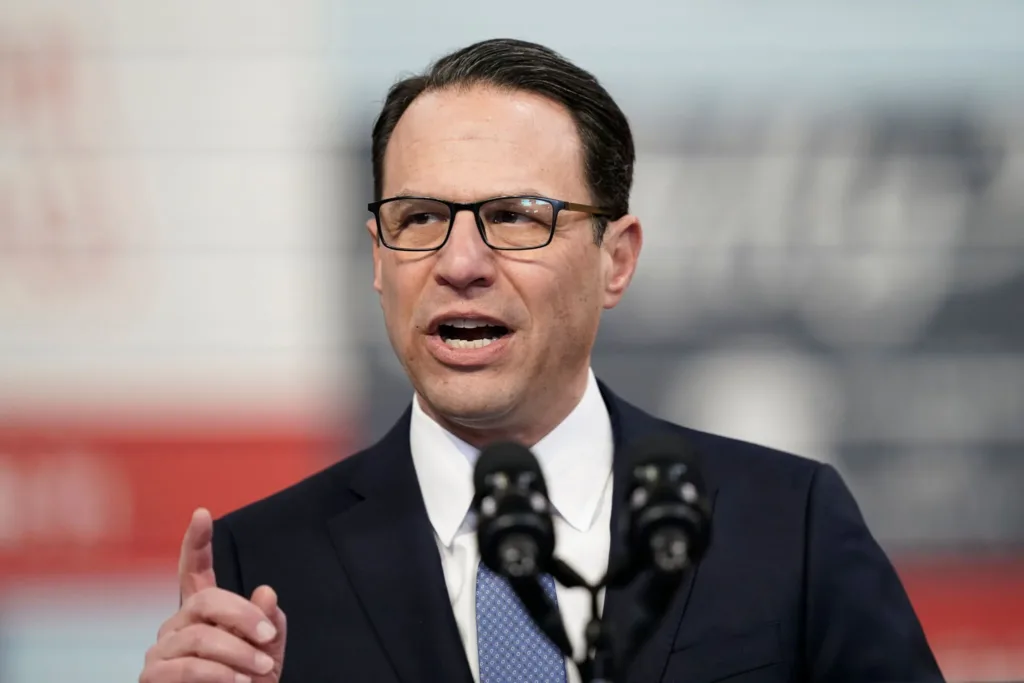
FILE - Pennsylvania Gov. Josh Shapiro speaks at the Finishing Trades Institute on March 9, 2023, in Philadelphia. Gov. Shapiro's administration said starting Tuesday Sept. 19 2023 it is making it easier for someone to register to vote when they are getting or renewing a driver's license in Pennsylvania. (AP Photo/Matt Rourke, File)
Aspects of the plan will include lowering tuition at state-owned universities, streamlining degree programs and funding institutions based, at least in part, on performance metrics. It also would mean more grant money, including for students who attend private universities in Pennsylvania.
HARRISBURG — Gov. Josh Shapiro plans next month to propose an overhaul of a higher education system in Pennsylvania that is among the worst in the nation in affordability, his administration said Friday.
Aspects of the plan will include lowering tuition at state-owned universities, streamlining degree programs and funding institutions based, at least in part, on performance metrics. It also would mean more grant money, including for students who attend private universities in Pennsylvania.
The administration did not release many specifics and said the Democratic governor would give more details in his Feb. 6 budget address, using ideas that sprang from a working group of college and university presidents assembled by Shapiro last year.
In his budget address last year, Shapiro said it is time “to rethink our system of higher education – because what we’re doing isn’t working.”
By just about every measure there is, Pennsylvania is ranked at the bottom among states in the level of higher education aid, size of student debt and affordability of its colleges. Pennsylvania ranks 48th in higher education affordability and spends less per capita on higher education aid than any other state except New Hampshire, Shapiro’s administration said.
This year’s state government spending of $2 billion on higher education is the same as it was 15 years ago.
In a 2021 analysis, the nonprofit Center on Budget and Policy Priorities said Pennsylvania was neck-and-neck with South Carolina, Mississippi and Alabama for the highest price of a public four-year university as a share of median household income, at 34%. The lowest states were at less than half that share.
Meanwhile, enrollment at community colleges and state-owned universities has dropped by about one-third the past decade, the administration said.
In his budget, Shapiro will propose “significant” aid for state-owned universities, community colleges and their students, the administration said. In addition, Shapiro will seek to raise grants by $1,000 — up from the maximum award of $5,750 — for Pennsylvania students who attend college in the state.
The 10 state-owned universities — including 14 campuses — and 15 independent community colleges should be united under a governance system that improves coordination between the schools and lowers costs by limiting the competition and duplication between them, the administration said.
After that, Shapiro wants to cut tuition and fees at state-owned universities to no more than $1,000 a semester for Pennsylvania students whose household income is below the state median of about $70,000.
The administration could not immediately say how much money the plan would require, where Shapiro would get the money or where that amount of aid would place Pennsylvania in state rankings.
It could, however, easily cost upwards of $200 million a year.
Tuition and fees at state-owned schools can run about $11,000 a year, not including the cost of a dorm room and meal plan that can run another $10,000.
Eventually, the state would develop an aid formula rewarding higher education institutions for factors including growing enrollment and graduation rate, the administration said.
Schools would get incentives to recruit and support students to complete degrees and earn credentials in growing fields and fields with workforce shortages, the administration said.
Much of the plan would not affect the state’s largest universities, including Penn State, Temple and Pitt, which are getting nearly $600 million in aid this year to help subsidize tuition for in-state students.
Enrollment at the state-owned university system, called the Pennsylvania’s State System of Higher Education, has fallen steadily the past two decades from over 100,000, and is now just under 83,000, according to system figures. Of that, 88% are from Pennsylvania.
The system’s data shows it has seen a significant drop-off in students from families whose household income is below $100,000.

Cyber charter schools in Pennsylvania would see funding cut under bill passed by the state House
A Democratic-sponsored proposal to limit per-student payments to Pennsylvania's cyber charter schools and make other changes to how they operate...

Starting a career in public education? Bucks County districts pay higher than average
New Hope-Solebury and Centennial school districts have the first and second highest average new teacher salaries in the state at $95,446 and...

Opinion: New poll finds Pennsylvanians oppose dismantling US Department of Education
Imagine for a moment what would happen if the public schools in your community suddenly lost millions of dollars in resources for student programs....

Centennial hires Abram Lucabaugh as superintendent. The vote wasn’t unanimous
A divided Centennial School Board voted Tuesday night to hire former Central Bucks Superintendent Abram Lucabaugh as the district’s next educational...

Penn State trustees vote to close 7 branch campuses amid declining enrollments
Penn State University's trustees voted Thursday night to close seven of its 19 branch campuses amid declining enrollments, demographic shifts and...




